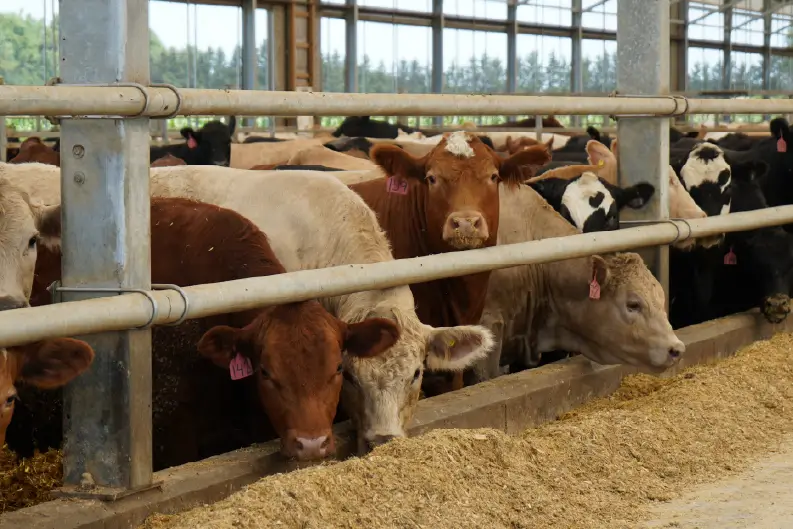By: Hannah Simpson,
Ruminant Nutritionist
Grand Valley Fortifiers
Why Forage Test?
Forage analysis is often something producers may overlook due to costs; however, the analysis of forages is a valuable tool for developing feeding strategies for beef cattle which are cost and resource efficient. By testing your forages, nutritionists and beef specialists can develop a deeper understanding of the nutritional level of a given forage, allowing for intensified feed management, and ensuring nutritional demands of the herd are being met.
If you’re not testing, then you’re guessing! When on farm forages are not tested, sneaky production problems such as poor average daily gain and decreased conception can be caused by mineral and/or nutrient deficiencies or excesses, mycotoxins, and nitrates. Additionally, having a current forage analysis can ensure there are no nutritional gaps, with all nutritional needs of beef cattle being met during each stage of production. As stages of production progress, the nutritional needs of your cattle will vary whether you are breeding, growing, or finishing the group. Factors such as body condition score, hair coat, and hide thickness will impact the nutritional requirements, and even environmental factors such as weather patterns, mud depth, and bunk space can impact requirements. In terms of cost benefits, feeding programs can be optimized as a least cost formulation as well as having the opportunity to accurately price feed when buying or selling forages.
Avoiding Costly Problems
One of the largest benefits of testing your forages is the mitigation of costly problems before they impact your cattle. With forage quality and quantity varying year to year, with some years having exceptional yields and other years having to outsource forages, forage testing becomes essential.
Molds & Toxins
Similar to grains, mold can occur in forages due to certain plant diseases, such as ergot. As weather patterns change, the incidence of plant diseases will increase in times of wet growing conditions. The incidence of molds can dramatically affect the overall palatability of the feed, in addition to the energy content, as well as create reproduction and health problems due to the presence of mycotoxins. Mycotoxins being present in your forage such as vomitoxin, fuminosins, and aflatoxin can lead to poor reproductive performance, depressed gains, and in serious cases death. Although avoiding molds in forages isn’t always possible, testing your forages to determine the potential severity of the problem can help nutritionists find a realistic solution.
Mineral Nutrition
Forage quality has a substantial impact on mineral nutrition, as mineral availability within forages will fluctuate depending on seasonality, quality, plant species, and processing methods. Trace minerals such as zinc, copper, and manganese require supplementation as they are important pieces in terms of reproduction, health, and growth of any beef animal. Additionally, minerals such as molybdenum and sulfur, due to their antagonistic properties can alter a cows’ ability to absorb zinc, copper, and manganese. Certain soils and therefore forages can be high in molybdenum, leading to copper deficiencies which producers may be unaware of. It is highly recommended to supplement with minerals year-round, and work with a nutritionist to understand how a mineral program can be supplemented with the forages available to ensure all animal requirements are being met 365 days a year.
How to Interpret a Forage Analysis
Labs such as Cumberland Valley Analytical Services provide forage analysis services and information such as moisture content, crude protein, total digestible nutrients, vitamins, and minerals. When reviewing a forage test, the analysis can contain values which may be confusing. Below is a brief explanation of some of the most important factors when understanding your farms forages:
- Dry Matter (DM%): Refers to the moisture content of the given forage sample. Moisture and dry matter content as a percent will always equal 100.
- Crude Protein (CP%): Estimate of protein is based on multiplying feed sample nitrogen content by 6.25.Non-protein nitrogen (NPN) includes sources such as urea, which can increase CP.
- Neutral Detergent Fibre (NDF%: Suggests the amount of fibre content within a forage.Mature forages will have increased NDF%.
- Acid Detergent Fibre (ADF%): Includes cellulose and lignin to account for the least digestible parts of the forage. High ADF can indicate that forage digestibility is poor and more mature.
- uNDF (240hr): Predicts forage digestibility, as it is the portion of NDF that is not digested after 240 hours.Best predictor for forage intake potential
- Relative Forage Quality (RFQ): A report card for overall forage quality (higher=better). Estimates intake and TDN%. RFQ will vary on grasses vs legume forages.
Interested in Testing Your Forages?
If forage testing is something you would like to implement on your farm, below are a few steps to begin the process of improving your herds overall nutrition:
01. Determine your forage resources. Does your forage inventory align with amounts being fed?
02. Evaluate what your goals are for forage testing. What is your motivation behind forage testing?
03. Think of potential problems you are trying to avoid. Are mycotoxins or mineral interactions a problem in your herd?
Take Home Message
Investing in forage testing is a low-cost, high-gain tool that can assist in making educated decisions that will have long lasting effects, thus benefiting farm economics and cattle health. Contact your local Grand Valley Fortifiers representative to begin testing your forages!
This article was written for the Spring 2024 Central & Atlantic Beef Grist. To read the whole Beef Grist, click the button below.

